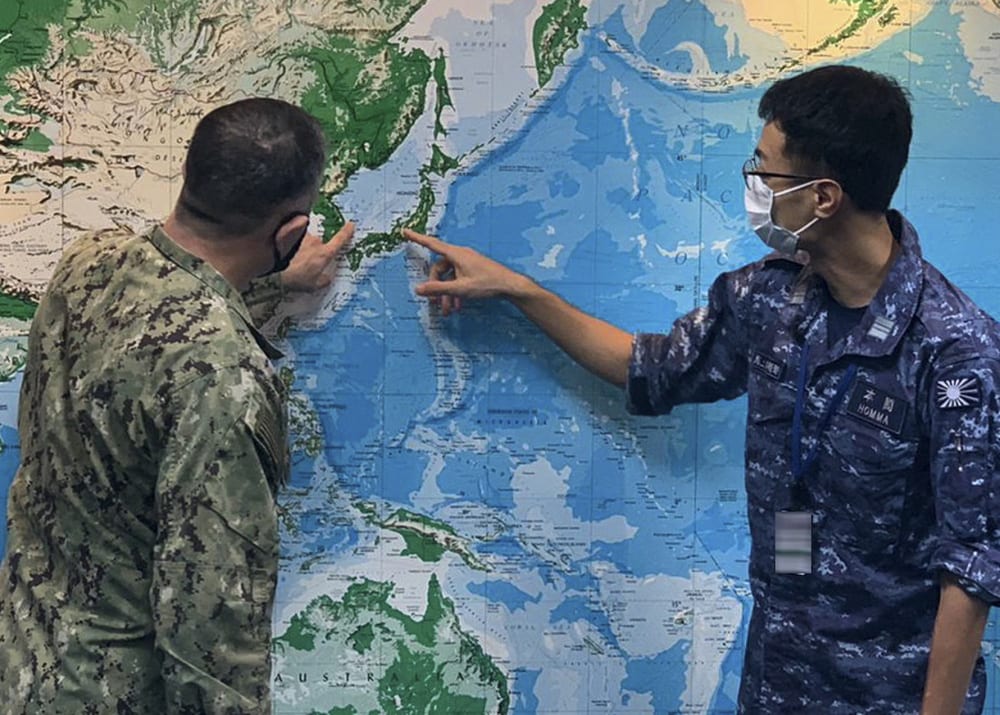
To maintain a naval presence throughout the vast Indo-Pacific area of operations requires a logistics network that can supply and sustain naval ships while they are at sea. Singapore-based Commander, Logistics Group Western Pacific (COMLOG WESTPAC)/Task Force 73 (CTF 73), is the U.S. 7th Fleet’s provider of combat-ready logistics, operating government-owned and contracted ships to keep those ships armed, fueled and fed.
That includes the scheduling and coordination of the combat logistics force (CLF).
The Military Sealift Command operates three different classes of CLF ships. The 45,000-ton, 689-foot USNS Lewis and Clark class of Dry Cargo/Ammunition Ships (T-AKEs) deliver ammunition, food, fuel, parts and supplies and material to the fleet. The Henry J. Kaiser Class T-AOs are 677 feet long and displace more than 40,000 tons, carrying 180,000 barrels of aviation and diesel fuel for ships and aircraft deployed at sea. The 49,000-ton, 754-foot Supply-class of Fast Combat Support ships (AOE) can keep up with the carrier strike groups to bring 177,000 barrels of oil; 2,150 tons of ammunition; 500 tons of dry stores; and 250 tons of refrigerated stores to Navy task forces.
CTF 73 supports almost every exercise and operation that occurs in 7th Fleet, whether directly or indirectly. “The vastness of Seventh Fleet and shear number of ships demand teamwork between CTF 73 and Military Sealift Command Far East,” said Lt. Catherine Anthony, surface operations officer at Commander, Logistics Group Western Pacific. “Logistics is what enables our fleet to sustain at sea. Without our ability to [replenish at sea], combatants would be tethered to port, and we would not have the same power projection, flexibility, and mobility we as a Navy have become accustomed to.”
CTF 73’s mission also includes supporting, and being supported by, U.S. allies and partners in the region.
One of the closest of those partners is the Japan Maritime Self-Defense Force (JMSDF). Evidence of that cooperation is establishment and assignment of a JSMDF liaison officer (LNO), Lt. Cmdr. Shuzo Homma, at COMLOG WESTPAC/CTF 73. Homma works directly with the staff’s replenishment officer to ensure the interchangeability and combined logistics operations between the two services involving Military Sealift Command and JMSDF ships.
As LNO, Homma coordinated with Military Sealift Command Far East to execute numerous underway replenishments for U.S. and JMSDF ships.
“If we can achieve more-advanced and interchangeable logistics in the areas where both the U.S. Navy and JMSDF operate, we can achieve better efficiencies in the use of our CLF assets and extend our ability to support units further from logistics hubs,” said Homma.
Replenishment operations involve refueling at sea and the delivery of provisions via connected or vertical replenishments. Homma points to a replenishment-at-sea (RAS) between the JMSDF Masyuu-class supply ship JS Oumi (AOE 426) and the Arleigh Burke-class guided missile destroyer USS John S. McCain (DDG 56) as a prime example of what the two navies can accomplish together.
“That was the first RAS that delivered cargo and fuel to a U.S. ship that was engaged in operations from a JMSDF oiler,” said Homma. “In order to accomplish this event, we needed to work on both operational and legal issues related to ACSA [Acquisition and Cross-Servicing Agreement]. We were able to load U.S. supply parts and U.S. subsistence on a JMSDF logistics ship and deliver them during a RAS event. This is a process that could take weeks and we did it in days.”
The positioning of a JMSDF LNO at CTF 73 is a combined U.S. Pacific Fleet/JMSDF effort developed by the JMSDF/U.S. Navy Logistics Interoperability and Integration Strategic Framework. The goal is to build better interoperability and interchangeable logistics between JMSDF and U.S. Navy forces in the 7th Fleet area of operations.
“Our combined logistics capabilities play a big role in our navies’ abilities to operate effectively, efficiently and interchangeably in the Indo-Pacific,” said Lt. Cmdr. Cory Eggers, CTF 73’s fleet replenishment officer. “Having a JMSDF LNO here in Singapore and being able to work together, in person, to put the pieces together and overcome logistical challenges has absolutely enhanced our efforts.”
“Interoperable and interchangeable logistics require trust. We can move fuel and parts with speed, but only as far and fast as our network can take us. This partnership builds the collective strength, speed and operational reach of our supply chains,” said Capt. Chuck Dwy, assistant chief of staff for logistics at COMLOG WESTPAC, who was instrumental in developing the LNO program.
“The LNO program reflects the trust we place in partners at every level,” said Rear Adm. Joey Tynch, commander of COMLOG WESTPAC/CTF 73.
- A Day to Remember - September 11, 2023
- Indo-Pacific Maritime Security Exchange will examine emerging capabilities and capacity - July 12, 2023
- Cold Waters Spark Warm Relationship - April 20, 2023






